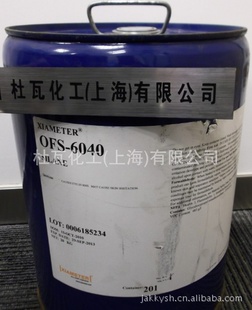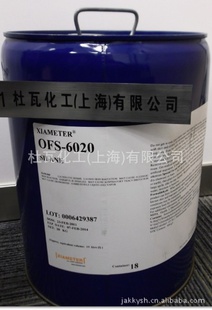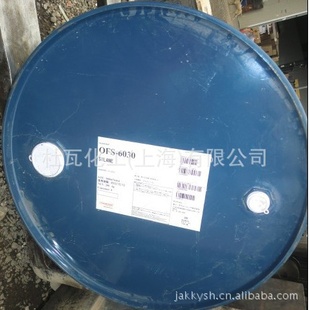产品详细说明:
美国原装进口
XIAMETER®OFS-6040硅烷2009年7月20日XIAMETER®是道康宁公司的注册商标。Ref.No. 95-443-40Dow Corning®是道康宁公司的注册商标。. ©009道康宁公司版权所有。
代理商:杜瓦化工(上海)有限公司
ADD:上海市牡丹路60号(东辰大厦5F) TEL:021-61558956/7 FAX:021-39650332 MB:13916161765
.
XIAMETER® OFS-6040硅烷
用于提高有机树脂对无机表面粘合性的偶联剂
特性
•环氧反应性
•甲氧基硅烷无机反应性
优点
•提高粘合性
•提高复合材料强度
•提高复合材料干/湿抗拉强度和
模量
•提高复合材料干/湿抗弯强度和
模量
•提高干/湿抗压强度
•更好的外观
•更好的填料润湿与分散
•更低的填充液体树脂粘度
•更佳的加工性能
组成
•γ-缩水甘油醚丙基三甲氧基硅烷
应用
•用于各种表面处理和偶联剂应用
•用作多种树脂的粘合促进剂
•与多种树脂和填料相容
典型物理性能
至规范制定者:以下数据仅供参考,不得直接用于规格制订。
特性 | 单位 | 数值 |
外观 | 澄清液体 | |
颜色 | APHA | 50 |
粘度 | cst | 3 |
25oC (77oF)时的比重 | 1.07 | |
折射率 | 1.428 | |
闭杯闪点 | oC (oF) | >101 (>213) |
Purity by GC | % | >98.5 |
氯化物 | ppm | 214 °F / > 101.1 °C (Closed Cup)251.6 °F / 122 °C (Cleveland Open Cup)Autoignition Temperature: Not determined.Flammability Limits in Air: Not determined.Extinguishing Media: On large fires use dry chemical, foam or water spray. On small fires use carbon dioxide(CO2), dry chemical or water spray. Water can be used to cool fire exposed containers.XIAMETER(R)Material Safety Data SheetPage: 3 of 9Version: 2.2Revision Date: 2010/10/07XIAMETER(R) OFS-6040 SILANEFire Fighting Measures: Self-contained breathing apparatus and protective clothing should be worn in fighting largefires involving chemicals. Determine the need to evacuate or isolate the area according toyour local emergency plan. Use water spray to keep fire exposed containers cool.Unusual Fire Hazards: None.6. ACCIDENTAL RELEASE MEASURESContainment/Clean up: Determine whether to evacuate or isolate the area according to your local emergency plan.Observe all personal protection equipment recommendations described in Sections 5 and 8.For large spills, provide diking or other appropriate containment to keep material fromspreading. If diked material can be pumped, store recovered material in appropriatecontainer. Clean up remaining materials from spill with suitable absorbant. Clean area asappropriate since spilled materials, even in small quantities, may present a slip hazard. Finalcleaning may require use of steam, solvents or detergents. Dispose of saturated absorbant orcleaning materials appropriately, since spontaneous heating may occur. Local, state andfederal laws and regulations may apply to releases and disposal of this material, as well asthose materials and items employed in the cleanup of releases. You will need to determinewhich federal, state and local laws and regulations are applicable. Sections 13 and 15 of thisMSDS provide information regarding certain federal and state requirements.Note: See Section 8 for Personal Protective Equipment for Spills.7. HANDLING AND STORAGEUse with adequate ventilation. Product evolves flammable methyl alcohol when exposed to water or humid air. Provideventilation during use to control exposure within Section 8 guidelines or use air-supplied or self-contained breathingapparatus. Do not get in eyes. Avoid skin contact. Avoid breathing vapor. Keep container closed.Keep container closed and store away from water or moisture.8. EXPOSURE CONTROLS / PERSONAL PROTECTIONComponent Exposure LimitsCAS Number Component Name Exposure Limits2530-83-8 Glycidoxypropyl trimethoxysilane Dow Corning guide: TWA 5 ppm, STEL 10 ppm.See methyl alcohol comments.Methyl alcohol forms on contact with water or humid air. Provide adequate ventilation to control exposures withinguidelines of OSHA PEL: TWA 200 ppm and ACGIH TLV-skin: TWA 200 ppm, STEL 250 ppm.Engineering ControlsLocal Ventilation: Recommended.XIAMETER(R)Material Safety Data SheetPage: 4 of 9Version: 2.2Revision Date: 2010/10/07XIAMETER(R) OFS-6040 SILANEGeneral Ventilation: Recommended.Personal Protective Equipment for Routine HandlingEyes: Use chemical workers goggles.Skin: Wash at mealtime and end of shift. Contaminated clothing and shoes should be removed assoon as practical and thoroughly cleaned before reuse. Chemical protective gloves arerecommended.Suitable Gloves: Avoid skin contact by implementing good industrial hygiene practices and procedures. Selectand use gloves and/or protective clothing to further minimize the potential for skin contact.Consult with your glove and/or personnel protective equipment manufacturer for selection ofappropriate compatible materials.Inhalation: Use respiratory protection unless adequate local exhaust ventilation is provided or exposureassessment demonstrates that exposures are within recommended exposure guidelines. IHpersonnel can assist in judging the adequacy of existing engineering controls.Suitable Respirator: General and local exhaust ventilation is recommended to maintain vapor exposures belowrecommended limits. Where concentrations are above recommended limits or are unknown,appropriate respiratory protection should be worn. Follow OSHA respirator regulations (29CFR 1910.134) and use NIOSH/MSHA approved respirators.Personal Protective Equipment for SpillsEyes: Use full face respirator.Skin: Wash at mealtime and end of shift. Contaminated clothing and shoes should be removed assoon as practical and thoroughly cleaned before reuse. Chemical protective gloves arerecommended.Inhalation/SuitableRespirator:Respiratory protection recommended. Follow OSHA Respirator Regulations (29 CFR1910.134) and use NIOSH/MHSA approved respirators. Protection provided by air purifyingrespirators against exposure to any hazardous chemical is limited. Use a positive pressure airsupplied respirator if there is any potential for uncontrolled release, exposure levels areunknown, or any other circumstance where air purifying respirators may not provide adequateprotection.Precautionary Measures: Do not get in eyes. Avoid skin contact. Avoid breathing vapor. Keep container closed. Usereasonable care.XIAMETER(R)Material Safety Data SheetPage: 5 of 9Version: 2.2Revision Date: 2010/10/07XIAMETER(R) OFS-6040 SILANEComments: Product evolves flammable methyl alcohol when exposed to water or humid air. Provideventilation during use to control exposure within Section 8 guidelines or use air-supplied orself-contained breathing apparatus.When heated to temperatures above 150°C (300°F) in the presence of air, product can formformaldehyde vapors. Formaldehyde is a potential cancer hazard and a known skin andrespiratory sensitizer. Vapors irritate eyes, nose, and throat. Safe handling conditions may bemaintained by keeping vapor conditions within the OSHA permissible exposure limit forformaldehyde.Note: These precautions are for room temperature handling. Use at elevated temperature or aerosol/spray applications may requireadded precautions. For further information regarding aerosol inhalation toxicity, please refer to the guidance document regarding theuse of silicone-based materials in aerosol applications that has been developed by the silicone industry () or contactthe Dow Corning customer service group.9. PHYSICAL AND CHEMICAL PROPERTIESPhysical Form: LiquidColor: Colorless to pale yellowOdor: Aromatic odorSpecific Gravity @ 25°C: 1.07Viscosity: 3 cStFreezing/Melting Point: Not determined.Boiling Point: >= 250.00 °CVapor Pressure @ 25°C: Not determined.Vapor Density: Not determined.Solubility in Water: Not determined.pH: Not determined.Volatile Content: Not determined.Flash Point: > 214 °F / > 101.1 °C (Closed Cup)251.6 °F / 122 °C (Cleveland Open Cup)Autoignition Temperature: Not determined.Flammability Limits in Air: Not determined.Note: The above information is not intended for use in preparing product specifications.10. STABILITY AND REACTIVITYChemical Stability: Stable.HazardousPolymerization:Hazardous polymerization will not occur.Conditions to Avoid: None.Materials to Avoid: Oxidizing material can cause a reaction. Water, moisture, or humid air can cause hazardousvapors to form as described in Section 8.Hazardous Decomposition ProductsXIAMETER(R)Material Safety Data SheetPage: 6 of 9Version: 2.2Revision Date: 2010/10/07XIAMETER(R) OFS-6040 SILANEThermal breakdown of this product during fire or very high heat conditions may evolve the following decompositionproducts: Carbon oxides and traces of incompletely burned carbon compounds. Silicon dioxide. Formaldehyde.11. TOXICOLOGICAL INFORMATIONComponent Toxicology InformationGlycidoxypropyltrimethoxysilane (GPTMS) was weakly mutagenic in the Ames test, mouse lymphoma assay, and an invitro sister chromatid exchange test; however results of in vivo genotoxicity studies have shown mixed results. Repeatedexposure of rats or rabbits to this material did not result in an increase in sister chromatid exchange, while singleexposures of mice to a hydrolyzate of this material resulted in a significant increase in micronucleated polychromaticerythrocytes. The potential relevance to humans is not known; however, it is unlikely that this material presents asignificant genotoxic hazard, in that it lacks any local tumorigenic response to the chronic recurrent application to mouseskin.This material may liberate methanol upon exposure to moisture or humid air. Overexposure to methanol can result inblindness and nervous system effects.Special Hazard Information on ComponentsMutagensCAS Number Wt % Component Name2530-83-8 85.0 - 100.0 Glycidoxypropyl trimethoxysilane Genetically active in somatic cells in INVIVO assay(s).Genetically active in IN VITRO and INVIVO assay(s).12. ECOLOGICAL INFORMATIONEnvironmental Fate and DistributionComplete information is not yet available.Environmental EffectsComplete information is not yet available.Fate and Effects in Waste Water Treatment PlantsComplete information is not yet available.Ecotoxicity Classification CriteriaHazard Parameters (LC50 or EC50) High Medium LowAcute Aquatic Toxicity (mg/L) 1 and 100XIAMETER(R)Material Safety Data SheetPage: 7 of 9Version: 2.2Revision Date: 2010/10/07XIAMETER(R) OFS-6040 SILANEAcute Terrestrial Toxicity 100 and 2000This table is adapted from "Environmental Toxicology and Risk Assessment", ASTM STP 1179, p.34, 1993.This table can be used to classify the ecotoxicity of this product when ecotoxicity data is listed above. Please read the other information presented in thesection concerning the overall ecological safety of this material.13. DISPOSAL CONSIDERATIONSRCRA Hazard Class (40 CFR 261)When a decision is made to discard this material, as received, is it classified as a hazardous waste? NoState or local laws may impose additional regulatory requirements regarding disposal.14. TRANSPORT INFORMATIONDOT Road Shipment Information (49 CFR 172.101)Not subject to DOT.Ocean Shipment (IMDG)Not subject to IMDG code.Air Shipment (IATA)Not subject to IATA regulations.15. REGULATORY INFORMATIONContents of this MSDS comply with the OSHA Hazard Communication Standard 29 CFR 1910.1200.TSCA Status: All chemical substances in this material are included on or exempted from listing on the TSCAInventory of Chemical Substances.EPA SARA Title III Chemical ListingsSection 302 Extremely Hazardous Substances (40 CFR 355):None.Section 304 CERCLA Hazardous Substances (40 CFR 302):None.Section 311/312 Hazard Class (40 CFR 370):Acute: YesChronic: YesXIAMETER(R)Material Safety Data SheetPage: 8 of 9Version: 2.2Revision Date: 2010/10/07XIAMETER(R) OFS-6040 SILANEFire: NoPressure: NoReactive: NoSection 313 Toxic Chemicals (40 CFR 372):None present or none present in regulated quantities.Note: Chemicals are listed under the 313 Toxic Chemicals section only if they meet or exceed a reporting threshold.Supplemental State Compliance InformationCaliforniaWarning: This product contains the following chemical(s) listed by the State of California under the Safe Drinking Waterand Toxic Enforcement Act of 1986 (Proposition 65) as being known to cause cancer, birth defects or otherreproductive harm.None known.MassachusettsNo ingredient regulated by MA Right-to-Know Law present.New JerseyCAS Number Wt % Component Name2530-83-8 85.0 - 100.0 Glycidoxypropyl trimethoxysilanePennsylvaniaCAS Number Wt % Component Name2530-83-8 85.0 - 100.0 Glycidoxypropyl trimethoxysilaneXIAMETER(R)Material Safety Data SheetPage: 9 of 9Version: 2.2Revision Date: 2010/10/07XIAMETER(R) OFS-6040 SILANE16. OTHER INFORMATIONPrepared by: Dow Corning CorporationThese data are offered in good faith as typical values and not as product specifications. No warranty, either expressed orimplied, is hereby made. The recommended industrial hygiene and safe handling procedures are believed to be generallyapplicable. However, each user should review these recommendations in the specific context of the intended use anddetermine whether they are appropriate.XIAMETER(R) is a trademark of Dow Corning Corporation |

















 发布供求信息
发布供求信息 推广企业产品
推广企业产品 建立企业商铺
建立企业商铺 在线洽谈生意
在线洽谈生意



